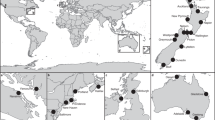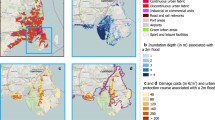Abstract
The quantitative analysis of hurricane impacts on coastal development in the Caribbean is surprisingly infrequent and many tools to assess physical vulnerability to sea level rise (SLR) are insufficient to evaluate risk in coastal areas exposed to wave attack during extreme events. This paper proposes a practical methodology to quantify coastal hazards and evaluate SLR impact scenarios in coastal areas, providing quantitative input for coastal vulnerability analysis. We illustrate the implementation of the proposed methodology with results from a site-specific analysis. We quantify how storm wave impacts penetrate farther inland and reach higher elevations for increasing SLR conditions. We also show that the increase in elevation of storm wave impacts is more than the nominal increase in mean sea level, and that elevation increase may be on the order of up to twice the nominal SLR. By developing design parameters for multiple scenarios, as opposed to the determination of a single SLR value for design established by consensus, this approach generates information that we argue encourages resilient design and embedding future adaptation in coastal design. We discuss how government planners and regulators, as well as real estate developers, lenders, and investors, can improve coastal planning and resilient design of coastal projects by using this approach.






Similar content being viewed by others
References
Bell G, Blake E, Landsea C, Kimberlain T, Goldenberg S, Schemm J, Pasch R (2012) Tropical cyclones Atlantic basin in state of the climate in 2011. Bull Am Meteorol Soc 93:S99–S105. https://doi.org/10.1175/2012BAMSStateoftheClimate.1
Bender M, Knutson T, Tuleya R, Sirutis J, Vecchi G, Garner S, Held I (2010) Modeled impact of anthropogenic warming on the frequency of intense Atlantic hurricanes. Science 327:454–458. https://doi.org/10.1126/science.1180568
Cambers G (1997) Planning for coastline change. Guidelines for construction setbacks in the eastern Caribbean islands. Coastal region and small island info 4, UNESCO. September 1997
Cambers G (2009) Caribbean beach changes and climate change adaptation. Aquatic ecosystem health and management 12(2):168–176, 2009. doi:https://doi.org/10.1080/14634980902907987
CARIBSAVE (2012) The CARIBSAVE climate change risk atlas – climate change risk profile for Saint Lucia. Caribbean Community Climate Change Centre. http://dms.caribbeanclimate.bz/M-Files/openfile.aspx?objtype=0&docid=5047. Accessed 22 November 2017
Colten C, Giancarlo A (2011) Losing resilience on the Gulf Coast: hurricanes and social memory. Environment: Science and Policy for Sustainable Development 53(4):6–19. https://doi.org/10.1080/00139157.2011.588548
Crabbe J (2014) Capacity building and policy development in Belize marine protected areas, an example for Caribbean integrated coastal management. Rev Biol Trop 62(Suppl. 3):287–291 September 2014, (Int. J. Trop. Biol. ISSN-0034-7744)
Dietrich J, Zijlema M, WesterinkJ HL, Dawson C, Luettich R, Jensen R, Smith J, Stelling G, Stone G (2011) Modeling hurricane waves and storm surge using integrally-coupled, scalable computations. Coast Eng 58(2011):45–65. https://doi.org/10.1016/j.coastaleng.2010.08.001
Elko N, Brodie K, Stockdon H, Nordstrom K, Houser C, McKenna K, Moore L, Rosati J, Ruggiero P, Thuman R, Walker I (2016) Dune management challenges on developed coasts. Shore and Beach 84(1):1–14
FEMA (2011) Coastal construction manual: principles and practices of planning, siting, designing, constructing, and maintaining residential buildings in coastal areas. FEMA P-55, Vol 1. 4th Edition. http://www.fema.gov/rebuild/mat/fema55.shtm. Accessed 3 June 2017
FEMA (2015) Numerical Models Meeting the Minimum Requirements of the National Flood Insurance Program. https://www.fema.gov/numerical-models-meeting-minimum-requirements-national-flood-insurance-program. Accessed 3 June 2017
FEMA (2016) Coastal Flood Risk Analysis and Mapping Process. https://www.fema.gov/media-library/assets/documents/116160. Accessed 6 June 2017
Guannel G, Ruggiero P, Faries J, Arkema K, Pinsky M, Gelfenbaum G, Guerry A, Kim C-K (2015) Integrated modeling framework to quantify the coastal protection services supplied by vegetation, J. Geophys. Res. Oceans, 120, doi:https://doi.org/10.1002/2014JC009821
Hinds D, Biondi E (2017) Overview - adapting to the new normal from siting through construction. Chapter 3 In: Honey M, Hogenson S (ed) Coastal tourism, sustainability, and climate change in the Caribbean, Vol I,business expert press, New York pp 54-66
Holland G, Belanger J, Fritz A (2010) A revised model for radial profiles of hurricane winds. Mon Weather Rev 138:4393–4401. https://doi.org/10.1175/2010MWR3317.1
Kates R, Colten C, Laska S, Leatherman S (2006) Reconstruction of New Orleans after hurricane Katrina: a research perspective. Proc Natl Acad Sci 103(40):14653–14660. https://doi.org/10.1073/pnas.0605726103
Knutson T, McBride J, Chan J, Emanuel K, Holland G, Landsea C, Held I, Kossin J, Srivastava A, Sugi M (2010) Tropical cyclones and climate change. Nat Geosci 3:157–163. https://doi.org/10.1038/ngeo779
Knutson T, Sirutis J, Vecchi G, Garner S, Zhao M, Kim H-S, Bender M (2013) Dynamical downscaling projections of twenty-first-century Atlantic hurricane activity: CMIP3 and CMIP5 model-based scenarios. J Clim 26:6591–6617. https://doi.org/10.1175/JCLI-D-12-00539.1
Luettich R, Westerink J, Scheffner N (1992) ADCIRC: an advanced three-dimensional circulation model for shelves coasts and estuaries, report 1: theory and methodology of ADCIRC-2DDI and ADCIRC-3DL. Dredging Research Program Technical Report DRP-92-6, U.S. Army Engineers Waterways Experiment Station, Vicksburg, MS, 137p
NGA (2018) NGA Product and Services https://www.nga.mil/ProductsServices/NauticalHydrographicBathymetricProduct
NOAA (2017) NWW3 Data Access http://polar.ncep.noaa.gov/waves/ensemble/download.shtml. Accessed 6 June 2017
Nurse L, McLean R, Agard J, Briguglio J, Duvat-Magnan V, Pelesikoti N, Tompkins E, Webb A (2014) Small islands. In: Climate change 2014: impacts, adaptation, and vulnerability. Part B: regional aspects. Contribution of working group II to the fifth assessment report of the intergovernmental panel on climate change Cambridge University Press, Cambridge, United Kingdom and New York, NY, USA, pp. 1613-1654, doi:https://doi.org/10.1017/cbo9781107415379
NYC (2017) Preliminary climate resiliency design guidelines. 04/21/2017 Version 1.0. NYC Mayor’s Office of Recovery and Resiliency. http://www.nyc.gov/html/planyc/downloads/pdf/publications/ORR_ClimateResiliencyDesignGuidelines_PRELIMINARY_4_21_2017.pdf. Accessed 6 June 2017
Ruggiero P (2013) Is the intensifying wave climate of the U.S. Pacific northwest increasing flooding and erosion risk faster than sea-level rise? J Waterw Port Coast Ocean Eng 2013(139):88–97. https://doi.org/10.1061/(asce)ww.1943-5460.0000172
Schleussner C-F, Lissner T, Fischer M, Wohland J, Perrette M, Golly RJ, Childers K, Schewe J, Frieler K, Mengel M, Hare W, Schaeffer M (2016) Differential climate impacts for policy-relevant limits to global warming: the case of 1.5°C and 2°C. Earth Syst Dynam 7:327–351. https://doi.org/10.5194/esd-7-327-2016
Scruggs G, Bassett T (2013) Coastal zone management, the Barbados model. Land Lines October 2013. The Lincoln Institute of Land Policy: Washington DC
Sheng Y, Alymov V, Paramygin V (2010) Simulation of storm surge, wave, currents, and inundation in the outer banks and Chesapeake Bay during hurricane Isabel in 2003: the importance of waves. J Geophys Res 115:C04008. https://doi.org/10.1029/2009JC005402
Simpson M, Scott D, Harrison M, Sim R, Silver N, O’Keeffe E, Harrison S, Taylor M, Lizcano G, Rutty M, Stager H, Oldham J, Wilson M, New M, Clarke J , Day O, Fields N, Georges J, Waithe R, McSharry P (2010) Quantification and magnitude of losses and damages resulting from the impacts of climate change: modelling the transformational impacts and costs of sea level rise in the Caribbean. United Nations Development Programme (UNDP), Barbados, West Indies
Simpson M, Colleen S, Clarke M, Clarke J, Scott D, Clarke A (2012) Coastal setbacks in Latin America and the Caribbean: final report, a study of emerging issues and trends that inform guidelines for coastal planning and development. Environmental and Social Safeguards Unit (VPS/ESG) of the Inter-American Development Bank. IDB Technical ote 476
Staneva J, Wahle K, Koch W, Behrens A, Fenoglio-Marc L, Stanev E (2016) Coastal flooding: impact of waves on storm surge during extremes – a case study for the German Bight. Nat Hazards Earth Syst Sci, 16, 2373–2389, 2016 doi:https://doi.org/10.5194/nhess-16-2373-2016
Sweet W, Kopp R, Weaver C, Obeysekera J, Horton R, Thieler E, Zervas C (2017) Global and regional sea level rise scenarios for the United States. NOAA Technical Report NOS CO-OPS 083. January 2017
ULI (2015) Returns on resilience: the business case. ULI Center for Sustainability. Washington, D.C.: the Urban Land Institute. ISBN: 978–0–87420-370-7 http://uli.org/wp-content/uploads/ULI-Documents/Returns-on-Resilience-The-Business-Case.pdf. Accessed 6 June 2017
UNCTAD (2014) Small island developing states: challenges in transport and trade logistics. Multi-Year Expert Meeting on Transport, trade logistics and trade facilitation, third session. 24-26/11/2014. http://unctad.org/meetings/en/SessionalDocuments/cimem7d8_en.pdf. Accessed 9 May 2017
UNECE (2013) Climate change impacts and adaptation for international transport networks. Expert Group Report, ITC, UN Economic Commission for Europe ECE/TRANS/238, 223 pp. http://www.unece.org/fileadmin/DAM/trans/main/wp5/publications/climate_change_2014.pdf. Accessed 9 May 2017
USACE (2013) Incorporating sea level change in civil works programs. ER 1100-2-8162 Department of the Army, U.S. Army Corps of Engineers Washington, DC 20314-1000
USACE (2017) CEDAS - Coastal Engineering Design and Analysis System https://chl.erdc.dren.mil/cedas/. Accessed 6 June 2017
Vitousek S, Barnard P, Fletcher C, Frazer N, Erikson L, Storlazzi C (2017) Doubling of coastal flooding frequency within decades due to sea-level rise. Scientific Reports 7, Article number: 1399 (2017) doi:https://doi.org/10.1038/s41598-017-01362-7
Vousdoukas M, Voukouvalas E, Mentaschi L, Feyen L (2016) Developments in large-scale coastal flood hazard mapping. Nat Hazards Earth Syst Sci 16(8):1841–1853. https://doi.org/10.5194/nhess-16-1841-2016
Acknowledgements
The authors acknowledge the invaluable support of Francis Way, PE and Heath Hansel, PE of Applied Technology & Management, Inc. They conducted the wave modeling studies for the consulting assignment used as case study, which was directed by the corresponding author. They provided the data for additional modeling and reviewed the case study description included herein. Matt Goodrich, PE, conducted the original storm surge modeling analysis used for the case study. We thank the confidential client of the consulting assignment, who authorized the use of all the site and model result data for this paper, with the only condition of confidentiality regarding the source and site.
Author information
Authors and Affiliations
Corresponding author
Rights and permissions
About this article
Cite this article
Biondi, E.L., Guannel, G. Practical tools for quantitative analysis of coastal vulnerability and sea level rise impacts—application in a Caribbean island and assessment of the 1.5 °C threshold. Reg Environ Change 18, 2227–2236 (2018). https://doi.org/10.1007/s10113-018-1397-4
Received:
Accepted:
Published:
Issue Date:
DOI: https://doi.org/10.1007/s10113-018-1397-4




